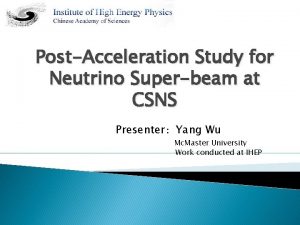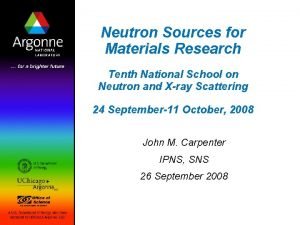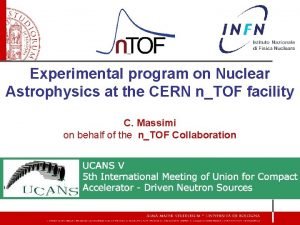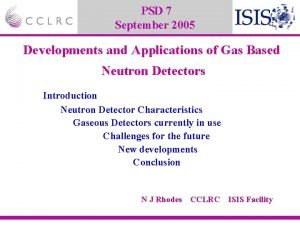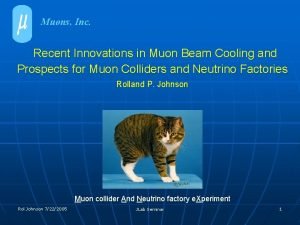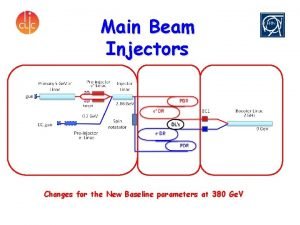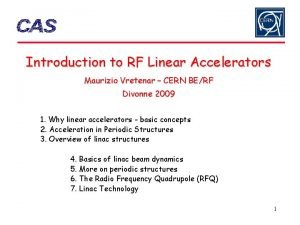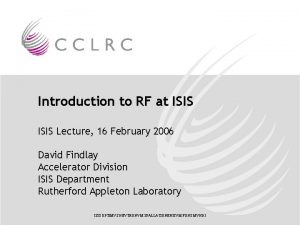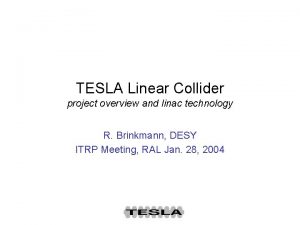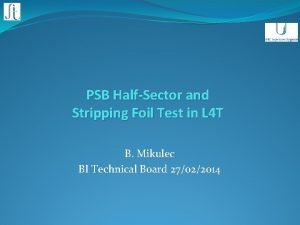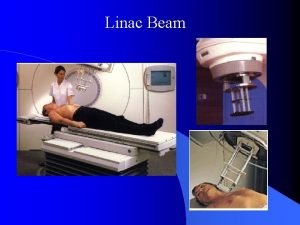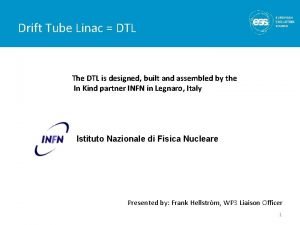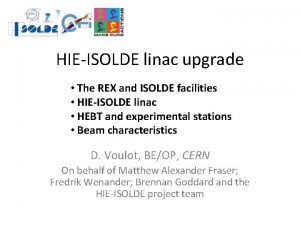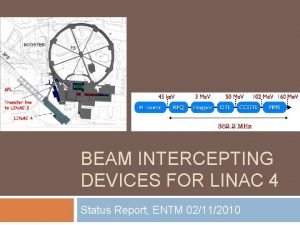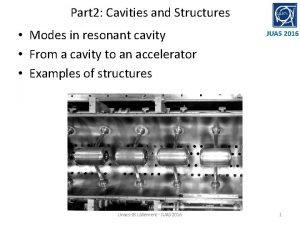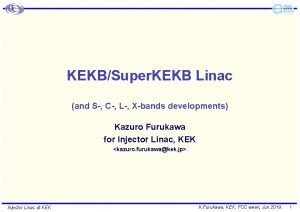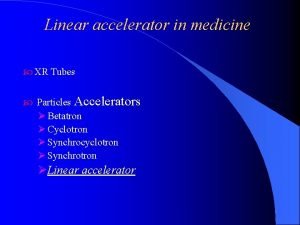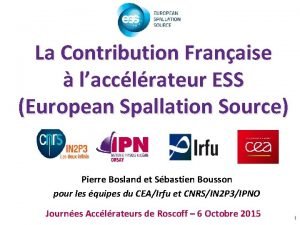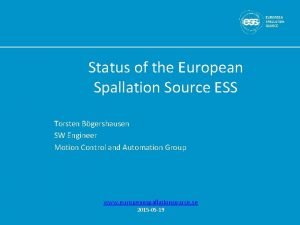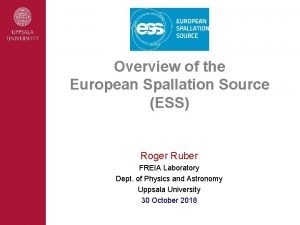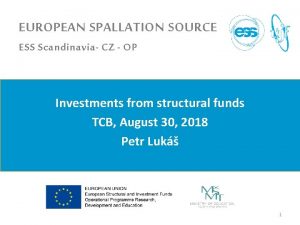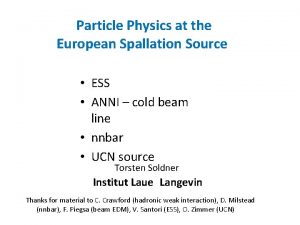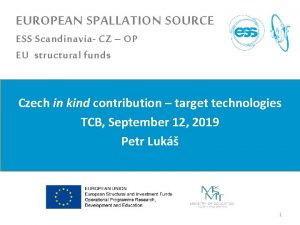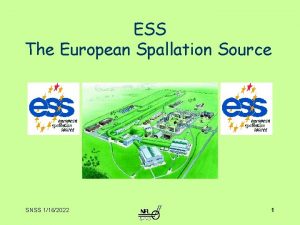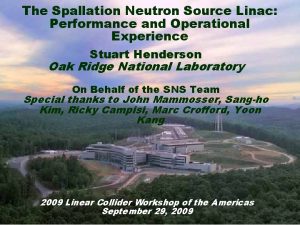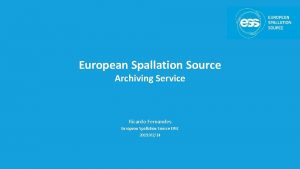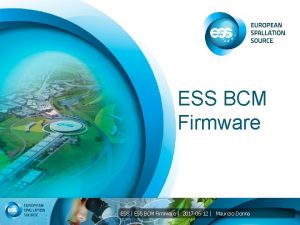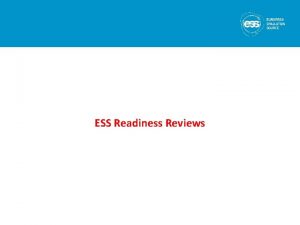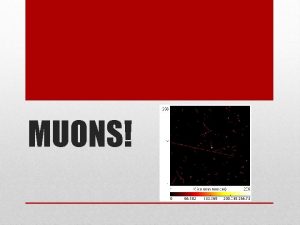Muons at ESS European Spallation Source Linac CERN
















- Slides: 16

Muons at ESS European Spallation Source Linac CERN, Nov. 2015 M. Dracos IPHC/CNRS-UNISTRA 1

European Spallation Source under construction phase (~1. 85 B€ facility) CERN, Nov. 2015 M. Dracos IPHC/CNRS-UNISTRA 2

ESS under construction CERN, Nov. 2015 Overview of site (Sep. 2015) M. Dracos IPHC/CNRS-UNISTRA Ion source building 3

How to add a neutrino facility? • Linac modifications: double the rate (14 Hz → 28 Hz), from 4% duty cycle to 8%. • Accumulator (ø 143 m) needed to compress to few μs the 2. 86 ms proton pulses, affordable by the magnetic horn (350 k. A, power consumption, Joule effect) • H- source (instead of protons) • space charge problems to be solved • ~300 Me. V neutrinos. • Target station (studied in EUROν). • Underground detector (studied in LAGUNA). • Short pulses (~μs) will also allow DAR experiments. CERN, Nov. 2015 M. Dracos IPHC/CNRS-UNISTRA 1. 1 x 1015 protons/pulse Nuclear Physics B 885 (2014) 127 4

ESSνSB near detector accumulator target station pro lin ac • First proton beam by 2019 • Full power/energy by 2023 February 2015 CERN, Nov. 2015 ton M. Dracos IPHC/CNRS-UNISTRA 5

ESS LINAC PROJECT SCHEDULE 2014 -11 -21 CERN, Nov. 2015 6 M. Dracos IPHC/CNRS-UNISTRA 6

Euro. Nu. Net (Combining forces for a novel European facility for neutrino-antineutrino symmetry-violation discovery) COST contributes to the objective of strengthening the scientific and technological bases of the European Research Area by promoting the networking of researchers, engineers or scholars encouraging them to share, create and apply knowledge, thereby encouraging Europe to become more competitive. Recently a COST network application for ESSu. SB was accepted. Quotation from the evaluation report: “The main strengths are that the present project is unique in Europe, and at this moment there are no other similar plans in the continent and it is building on a number of previous European projects. Only two other, similar projects exist in the USA and Japan. In addition, the project is not only complementary to the projects in the USA and Japan but clearly competitive with them, because the infrastructure proposed, which plans to locate the detector at the second neutrino oscillation maximum, will provide a much better and larger accuracy than the other two projects. ” CERN, Nov. 2015 M. Dracos IPHC/CNRS-UNISTRA 7

Target Station Shield Blocks General Layout Horn Support Module Split Proton Beam Collimators Horns and Targets Decay Volume (He, 25 m) Beam Dump CERN, Nov. 2015 M. Dracos IPHC/CNRS-UNISTRA Neutrino Beam Direction 8

Distributions at the level of the beam dump x (cm) muons at the level of the beam dump (per proton) y (cm) pions at the level of the beam dump (per proton) 3. 5 x 1020 π/year x (cm) 4. 2 x 1020 μ/year (16. 3 x 1020 for 4 m 2) 4. 1 x 1020 μ/year 3. 7 x 1020 π/year 2. 7 x 1023 p. o. t/year pions/proton (4 -target/horn) CERN, Nov. 2015 muons/proton (4 -target/horn) x (cm) M. Dracos IPHC/CNRS-UNISTRA x (cm) 9

Distributions at the level of the beam dump <Eπ>~0. 7 Ge. V <Lπ>~40 m pions/proton muons/proton <Eμ>~0. 46 Ge. V <Lμ>~2. 9 km E (Ge. V) nu. STORM • • CERN, Nov. 2015 significantly lower energy than nu. STORM muons (~3. 7 Ge. V) good to measure neutrino x-sections around 200 -300 Me. V M. Dracos IPHC/CNRS-UNISTRA 10

Beam for 6 D muon cooling nu. STORM iron absorber ~1010 m/pulse in 200 < P(Me. V/c) < 500 (if 1021 p/5 years → 4. 32 x 1017 μ/year) ESSνSB Input beam for future 6 D m cooling experiments muons/proton CERN, Nov. 2015 E (Ge. V) ~1012 m/pulse in 200 < P(Me. V/c) < 500 (for 1 m 2) (2. 6 x 1020 μ/year, at the level of the beam dump) M. Dracos IPHC/CNRS-UNISTRA 11

ESS-NUSTORM: a tentative layout J. P. Delahaye CERN, Nov. 2015 ESS_Nu. STORM M. Dracos IPHC/CNRS-UNISTRA 12

ESS neutrino and muons facility Neutrons to ESS proton driver Protons dump p decay Accumulator nm m Test Facility m+ or m. Front end m Decay channel or ring RLA acceleration Long Baseline Detector nm + ne ne + nm Storage ring Cooling RCS acceleration J. P. Delahaye CERN, Nov. 2015 Collider ring ESSnu. SB Short Baseline Detector Short nu. STORM Baseline Long Baseline Detector Neutrino Factory Muon Collider ESS_Nu. STORM M. Dracos IPHC/CNRS-UNISTRA 13

End CERN, Nov. 2015 M. Dracos IPHC/CNRS-UNISTRA 14

Beam characteristics CERN, Nov. 2015 M. Dracos IPHC/CNRS-UNISTRA 15

Which baseline for ESS nu. SB? Garpenberg Zinkgruvan CPV • systematic errors: 5%/10% (signal/backg. ) Stockholm University 2014 M. Dracos IPHC/CNRS-Ud. S 16
